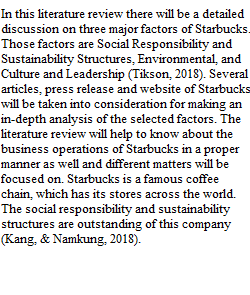


Q STOP: BEFORE YOU BEGIN THIS ASSIGNMENT BE SURE THAT YOU HAVE INSTRUCTOR APPROVAL FOR THE ORGANIZATION YOU WILL ANALYZE. NO TWO STUDENTS CAN USE THE SAME ORGANIZATION IN THIS CLASS. See Sample Literature Review in Week 5 Documents See also the Literature Review PowerPoint By Sunday midnight, submit a 3-4 page Literature Review for the Signature Assignment for this class. Remember you are using the same (instructor approved) organization for all three individual assignments in this class. Before beginning this assignment read the requirements for the Signature Assignment carefully as the Literature Review assignment is the start of the research and analysis for the Signature Assignment. This is not a paper, nor is it a formal Literature Review. It is a careful and organized list of appropriate sources that will be used for the final assignment. A Literature Review for this class is teaching students a practice of organization for their research. As an MBA graduate students will be assigned to research topics by their authority figures to determine the viability of an opportunity. You will also be performing a Literature Review in the MBA capstone. So learn this skill in this class! The Literature Review for this class has a minimum of three major areas of focus: Social Responsibility and Sustainability Structures Research the organization’s website and press releases and current job openings looking for evidence of a company focus on social responsibility and or sustainability. Also analyze any other business sources that have evidence of the company’s focus (Forbes, Bloomberg, Wall Street Journal, Harvard Business Review, etc.). Is there a presence for sustainability on the organizations Website? Is it mentioned in the Mission Statement? Look for lawsuits (perhaps class action?) or noncompliance fines that the company has had to pay. Investigations and probes into the company. What percentage of the total employment has sustainability in their job description? What public awards or recognition has the company or employees received for sustainability? What recommendations do you have for this organization? How would you rewrite their Mission or Vision Statement to include sustainability in their goals? How does this company structure demonstrate a focus on social responsibility (people, planet, profit). Remember you cannot cut paste from your first assignment in this class however you can use some of the same sources. Environmental What are the efforts to reduce water, air, energy, solid waste, transportation usage? Can you show demonstrated savings, either in what they have already done, or proposals for the future? Use material from the team assignment. Analyze if the company is “greenwashing” (if you are unfamiliar with this term - please look it up and cite what you find). For example, type in the name of your Fortune 500 company with the word “greenwashing” and see what credible sources you find. Then type in the name of your Fortune 500 company and “climate change policy” and compare and contrast what you find. Find the gaps between the company marketing/website/publicity and their actions on climate change. Be sure the findings from this section are highlighted in your Signature Assignment as this gap could provide the information you need for your recommendations. Culture and Leadership Research how culture, gender, demographics are currently affecting the organization. Look for percentage of women on the board, percentage of women officers, minority groups, turnover rates, and stock price and trends. Class action lawsuits by employees. Extra bonus points if you are able to calculate the income gap between the average worker in the organization and the CEO pay. Are suppliers being treated fairly, are consumers receiving a value for the money they spend on the organizations product and or service? Process for Writing of the Literature Review 1. Use APA Headings - each of the three areas of analysis above (Social Responsibility, Environmental and Culture and Leadership) are APA Level 2 Headings. The Level 1 Heading is “Literature Review” at the top of the page. 2. Find five to seven sources for each of the above areas of analysis cite them using APA and under each of the sources write three to five sentences of what the research means. 3. You may find several other areas that you want to analyze (most graduate students do). Make these additional areas of research Level 2 Headings as well. 4. After you cite each of the sources write three to five sentences of analysis for each source. Then go to the top of your page and write a short introduction for the Literature giving highlights of what has been found. The Introduction is about a half a page long. 5. After you have written the introduction go to the bottom of the page and write a short no more than half a page but at least three sentences conclusion for the work. 6. Then prepare a reference section (Level 1 Heading). You should have more than 15 sources in the whole literature review assignment (roughly five for each of the three topics above). Many graduate students will have more than 20 or even 30 sources for their Literature Review.
View Related Questions